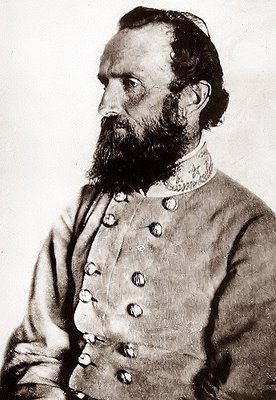


Stonewall Jackson (1824-1863)Thomas Jonathan Jackson was a great American general who fought for the South in the Civil War. General Robert E. Lee believed Jackson was irreplaceable and next to Robert E. Lee himself, Thomas J. Jackson is the most revered of all Confederate commanders. It was during the Battle of Bull Run at Manassas, Virginia, the first important battle of the Civil War, when Jackson assumed his nickname. Amidst the tumult of battle, Brigadeer-General Bernard Bee, a friend from Jackson's years at West Point, exclaimed: “Look, men, there is Jackson standing like a stone wall! Let us determine to die here, and we will conquer!” The South won the battle, and Jackson won the name “Stonewall.” Jackson was born on January 21, 1824, in Clarksburg, Virginia (now West Virginia). Both of his parents died when Thomas was a child. The orphaned young Thomas was taken in and raised by an uncle. Thomas helped around his uncle's farm, and much of his education was self-taught. He would stay up at night reading borrowed books by the light of burning pine knots. His uncle's grist mill is now the centerpiece of Jackson's Mill Center for Lifelong Learning and State 4-H Camp. Jackson was accepted to the Military Academy at West Point in July 1842. He became one of the hardest working cadets and moved steadily upward in the academic rankings. In spite of having started out with no formal education and experiencing difficulty with the entrance examination, he ended up graduating 17th out of 59 students in the Class of 1846. During his years as West Point cadet, Jackson began keeping a notebook in which he jotted down inspirational ideas and phrases from books that he read – such as “You may be whatever you resolve to be” – which he believed would aid him in the development of his character and intellect. He continued to add to this book throughout the 1850's. Jackson fought in the Mexican War from 1846-1848. After the war was over, Jackson resigned from the army and became a professor at the Virginia Military Institute in Lexington, Virginia. For the next ten years he taught artillery tactics as well as natural and experimental philosophy (related to modern day physics and including physics, astronomy, acoustics, optics, and other scientific courses). On August 4, 1853, Jackson married Elinor (Ellie) Junkin. Tragically, she died in childbirth on October 22, 1854 and their child, a son, was stillborn. Jackson was heartbroken. During the summer of 1856, Jackson went on a tour of Europe. He visited Belgium, France, Germany, Switzerland, England and Scotland. On July 16, 1857, Jackson married for the second time. His wife, Mary Anna Morrison, gave birth to a daughter on April 30, 1858. However, the baby died less than a month later. Jackson and Mary Anna moved to a modest brick townhouse at 8 East Washington Street in Lexington, Virginia early in 1859. The Jacksons spent the next two years furnishing their home, tending their garden, and involving themselves in the community. Jackson was still teaching at Virginia Military Institute and he was also a deacon in the Presbyterian Church, so his students called him “Deacon Jackson.” Jackson was a stern instructor and a quiet, profoundly religious man. No one suspected what a great military leader he would turn out to be. The Jacksons’ brief period of domestic tranquility came to an end on April 21, 1861, when Thomas and other VMI officers were ordered to go to Richmond at the start of the Civil War. Jackson was loyal to the state of Virginia and became a brigadier general in the Confederate Army. He was a skillful soldier and a fine leader, loved and respected by his men. He disliked fighting on Sunday, though that did not stop him from doing so. Jackson often led his soldiers in prayer. Serving under General Robert E. Lee, Jackson and his troops were victorious in the Shenandoah Valley, at Fredericksburg, and at the second Battle of Bull Run. Jackson and his men became famous for the speed at which they could march. Military historians also call Jackson an outstanding strategist and one of the most gifted tactical commanders in United States history. In December of 1862, Jackson was delighted to receive a letter about the birth of his daughter, Julia Laura Jackson, on November 23. She was the only Jackson child to survive into adulthood, although she died of typhoid fever at age 26. She and William Christian had two children, and both of Jackson's grandchildren had several children. Today there are many living descendants of Stonewall Jackson. Mrs. Jackson and baby daughter Julia came to visit Stonewall Jackson in April of 1863, but their nine-day reunion was interrupted by a renewal of fighting. Mary Anna had not seen her husband for more than a year prior to that, and she wrote that their latest tryst was all the more joyful because of “the additional charm and the attraction of the lovely child that God had given us.” To provide a keepsake of the happy occasion, Mrs. Jackson persuaded her husband to sit for a photograph. Unbeknownst to anyone at the time, this would be the last photograph of Jackson ever taken. On May 2, 1863, Jackson’s men helped defeat a northern army at Chancellorsville. But on that fateful night, as Jackson and some officers were coming back through the woods on horseback at twilight, they were mistaken for northern soldiers. Jackson was accidentally shot by one of his own men, and several other staff members were killed. In the darkness and confusion, Jackson was dropped from his stretcher while being evacuated. His wounded left arm was now broken and had to be amputated. General Robert E. Lee, the commander of all the Confederate armies, thought so highly of Jackson as his “right-hand man” that Lee sent a message saying, “Give him my affectionate regards, and tell him to make haste and get well, and come back to me as soon as he can. He has lost his left arm, but I have lost my right arm.” Sadly, Jackson contracted pneumonia following the surgery and died about a week later. Even as Jackson grew physically weaker, he remained spiritually strong, saying, "I thank God, if it is His will, that I am ready to go." Mary Anna was summoned to his bedside, when just eight days earlier she had left him in robust health. Sometime before he passed away, Jackson said, "It is the Lord's Day; my wish is fulfilled. I have always desired to die on Sunday." At the end, Jackson spoke out very cheerfully and distinctly the beautiful sentence which has become immortal as his last: “Let us cross the river and rest in the shade of the trees.” Stonewall Jackson was buried in Lexington, Virginia, in a plot that he bought himself as a burial place for his family. Jackson’s death was a severe setback for the Confederacy, affecting not only its military prospects but the whole morale of its army. Jackson’s wife wrote, “Tears were shed over that dying bed by strong men who were unused to weep.” It is said that The Army of Northern Virginia never fully recovered from the loss of Stonewall Jackson’s leadership in battle. After the war, Mary Anna returned with baby Julia to her father’s house in Charlotte, North Carolina. She always wore mourning clothes and never remarried. After her daughter’s untimely death in her late twenties, Mary Anna raised her two grandchildren. She wrote a biography about her husband, including some of his letters, published as the Memoirs of Stonewall Jackson in 1895. She also organized the Stonewall Jackson Chapter of the United Daughters of the Confederacy, in which she was elected President for life. Mary Anna Jackson remained a beloved figure in the South until her death in 1915 at the age of 83. References www.vmi.edu/archives.aspx?id=3747 (Stonewall Jackson resources from the Virginia Military Institute.) www.civilwarhistory.com/stonewalljackson/dofstowi.html (The death of Stonewall Jackson as told by his wife, Mary Anna Jackson.)
Contact: . Thanks! Please click here for reprint permission.


These pages are a continuous work in progress.
|
Help Support this Site
and purchase items via our affiliate links. Thank you!
 
Thank you for visiting my |

